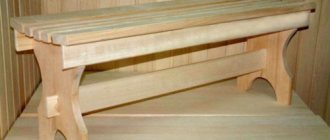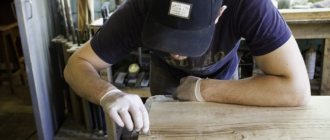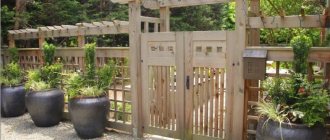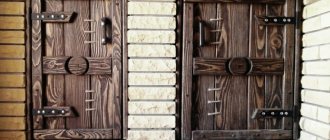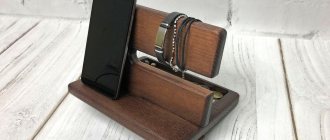Since ancient times, wood has been successfully used in construction work, furniture manufacturing, and interior and exterior decoration of buildings. The material is durable, environmentally friendly and easy to use, but in order for it to last for many years and not lose its attractive appearance, wood varnishes are used to process it, which protect the surface from abrasion and also allow the beautiful texture of the wood pattern to be left open.
What is varnish and where is it used?
Varnish is a viscous liquid that is applied to the surface of a wooden product and covers it with a thin film. It hardens over time. This substance contains resins and various polymers, which are usually dissolved in special solvents.
Looking at the catalog of the best varnishes, it can be noted that thanks to them the following problems are solved:
- the appearance of the wood is preserved and emphasis is placed on its texture;
- surfaces are decorated;
- the tree is protected from putrefactive processes and damage;
- help improve thermal insulation.
This material can be used for internal and external work. Its properties and scope of application depend on the structure. If you need to create a solid base, then it is advisable to buy an alkyd-urea variety; to protect against moisture, buy an alkyd substance, and to cover surfaces subject to heavy loads, buy an oil one.
There are 5 categories based on the degree of gloss, as can be seen from the photo of wood varnish:
- regular matte gives less than 10% gloss;
- semi-matte 10-15%;
- semi-gloss 40-50%;
- glossy 80-90%;
- super glossy over 90% gloss.
Popular brands of varnishes and reviews of them
Now let’s study customer reviews about different brands of wood varnish.
Review of Tikkurila Euro kiri parquet varnish:
More details on Otzovik: https://otzovik.com/review_7736932.html
wood varnish Tikkurila Euro kiri
Review of Feidal Pu Parket Moebellack parquet varnish:
More details on Otzovik: https://otzovik.com/review_2711271.html
Feidal Pu Parquet Moebellack
Review of alkyd-urethane varnish Parade “Yachts & Boats”:
More details on Otzovik: https://otzovik.com/review_2424326.html
Parade "Yachts & Boats"
Review of furniture varnish V33:
More details on Otzovik: https://otzovik.com/review_6719315.html
furniture varnish V33
Review of Tikkurila “Unica Super” urethane-alkyd varnish for wooden surfaces:
More details on Otzovik: https://otzovik.com/review_2199518.html
Tikkurila "Unica Super"
Review of Tikkurila Taika Glow matte varnish with glow effect:
More details on Otzovik: https://otzovik.com/review_8220069.html
Tikkurila Taika Glow
Gallery of products treated with decorative varnishes:
PHOTO: berkem.ru
PHOTO: parket03.ru
PHOTO: i.ytimg.com
PHOTO: mmvikont.ru
For interior work
By covering wooden structures indoors with liquid, you not only provide them with decorative properties, but also protect them from external influences. There are special substances for parquet and furniture, as well as universal materials.
The floor covering must be reliably protected, because it is under constant load. At the same time, you can choose the effect you prefer by purchasing glossy or matte wood varnish.
You also need to select the composition for different rooms. After all, in the bedroom the load on the parquet will be less than in the hallway or living room. Therefore, in the second case, higher quality material with additional protection will be required.
Experts also recommend selecting parquet coatings based on the degree of transparency, consistency and method of application. Parameters such as resistance to ultraviolet radiation and stress are also important. Among the substances used for flooring, primer, water-soluble, polyurethane, alkyd, and formaldehyde types are popular.
To protect furniture, high-quality and expensive analogues are used. They must maintain the natural appearance of wood. Therefore, the polyurethane type of material is most often used. It is also permissible to use oil, alkyd, acrylic and alcohol compounds.
It is important that the coating does not retain odor and that the film hardens quickly. Therefore, quick-drying wood varnish when processing furniture can be indispensable when carrying out urgent work.
Polyurethane varnishes: expert advice
Polyurethane varnishes for wood
This article will help you find out:
- When did they first start using polyurethane varnish for wood?
- What types of polyurethane varnishes for wood are there?
- What are the features of colored polyurethane varnish for wood
- How to care for a surface coated with polyurethane wood varnish
In our world today, products made from various polymers and high-tech composite materials have a leading position in almost all areas. Therefore, a material such as natural wood is especially valued from an aesthetic and material point of view. Wooden furniture adds a noble, eco-friendly and cozy touch to the overall interior. Wood is pleasant and convenient to process, and it has a number of other useful properties.
But it also has a drawback that should not be forgotten - without treatment, wood is afraid of moisture, technical fluids, does not tolerate mechanical stress and is poorly resistant to environmental conditions. You can reduce the negative consequences using various types of chemicals, one of them is polyurethane varnish for wood.
When did they first start using polyurethane varnish for wood?
Varnishes are viscous solutions that are applied in an even layer to the surface for protection. After drying, polyurethane varnish for wood forms a durable film; depending on the type of composition, it can have a pronounced or low shine.
The very first varnish coating was created in Germany in the 12th century by the monk Theophilus, who kept his recipe in the strictest confidence. However, many years later, historians found out that the main component of that varnish was alcohol. In the 15th–17th centuries, England sold and produced oil-type varnishes, also according to its own secret recipe.
Only in the second half of the 18th century was mass production of varnishes launched. The fact is that it was then that the French chemist published a detailed treatise on the preparation of this composition. In addition, active production of varnishes became possible after the emergence of new raw materials - resins from Portugal and Holland. In our country, we were one of the first, in 1874, to begin producing varnishes (of the highest grade, oil-based) in Moscow at the Osovetsky plant.
In the modern world, there are many more types of varnish coatings, and each of them has its own performance characteristics and type of film former.
Types of polyurethane varnishes for wood
Today on the market of construction and finishing materials you can find only two types of polyurethane varnishes for wood:
- One-component. Designed for outdoor woodwork, they are sold ready-made and do not require preliminary preparation. After hardening, they form a beautiful, durable film.
- Two-component. Otherwise called parquet varnish, they consist of a hardener and a base. Before work is carried out, the elements are combined in a separate container, after which a two-component polyurethane wood varnish is applied to the surface to be treated.
Remember: apply the two-component varnish carefully, but as quickly as possible. Accidentally getting into the composition of lint, chips, or dust particles can spoil the final appearance of the item. The varnish is diluted in the volume required for work, since even in an airtight container, the residues harden and cannot be used in the future.
Both types of polyurethane varnishes for wood (one-component, two-component) are presented today in two degrees of gloss:
- glossy;
- semi-matte.
The choice in this case depends on personal preferences and the characteristics of the selected tree.
Features of colored polyurethane varnish for wood
Thanks to colored polyurethane varnish for wood, it is possible to give the product a certain appearance. Beautiful and rich tones combined with wood texture make it possible to realize almost any creative idea.
Today you can find several varieties of colored varnish for wood, but polyurethane varnish remains the most popular. It consists of polyurethanes, as well as other compounds and additives. This composition is perfect for covering floorboards, parquet, laminate - then colored varnish is used for the floor, as well as for wooden walls and ceilings, decorative elements, and furniture.
A freshly made wooden product looks quite modest. You can give it a beautiful appearance using a special coating. And here the master has two options for action. First, he can coat the wooden surface with a ready-made colored varnish. Or pre-tint the material in the desired color and then treat the product with polyurethane wood varnish. Which option is better?
By choosing a colored polyurethane-based varnish for wood, it is possible to seriously reduce financial and time costs. Whereas in the second case, you need to purchase tinting and clear wood varnish. Next, you need to cover the wood with stain in one layer, then apply several layers of varnish, allowing each of them to dry. That is, this processing method requires quite a lot of time.
Advantages and disadvantages of polyurethane varnish for wood
First of all, let's talk about the advantages of polyurethane varnish for wood:
- It is well absorbed into the surface of the wood, making it resistant to abrasion.
- Protects the product from moisture, including salt water.
- Does not have an unpleasant odor.
- Durable and durable.
- Does not accumulate static electric charge and is not capable of conducting current.
All of the above turns polyurethane wood varnish into an effective way to process various products.
But this composition also has negative properties, namely:
- Some varnishes contain organic solvents that adversely affect human health when applied to the surface.
- Experts recommend abandoning polyurethane wood varnish when making furniture for children.
- Low-quality varnishes turn yellow over time.
- The price of a really good varnish is quite high.
In fact, all these shortcomings are unimportant; various additives that change and improve the properties of the varnish will help to cope with them.
Rules for applying polyurethane varnish for wood
Before treating the surface with polyurethane varnish for wood, it must be prepared: remove dirt and lint, if necessary, sand and polish. If we are talking about an outdoor wood product, it may require pre-treatment with a synthetic impregnation to further protect the item from mold, mildew and insects.
Polyurethane wood varnishes are applied by brush, roller or spray. All our materials are, of course, professional grade and therefore should only be applied by spraying. We will discuss this important spraying process, the selection of a spray gun and other equipment for this process in the corresponding article, and in this one we will pay attention to the application of varnishes at home.
The consistency of the composition depends on the type of application chosen. Typically, a one-component varnish must be diluted with a synthetic solvent. Let’s say that when applying the first method this is done by 5%, and for spray application – by 15%.
When working with two-component polyurethane varnish for wood, certain rules must be taken into account. The ingredients are mixed only in the proportions specified in the instructions. Otherwise, your varnish will be too viscous or harden very quickly. The two-component composition hardens quickly and cannot be used after that. Therefore, we repeat: it is better to mix such a volume of varnish that you can use it at one time.
It is better to apply two-component varnish with a mohair or fur roller. If you choose a brush, remember one rule: the roller or brush should move in the direction of the wood fibers. For a one-component varnish, a simple brush with synthetic bristles is also perfect. When treating a product with a complex surface with a one-component varnish, it is best to choose a sprayer.
It is recommended to apply polyurethane wood varnish in at least two layers. The instructions will tell you how long to wait before applying the second layer. Moreover, we advise you to follow this recommendation as accurately as possible, because overdried varnish, as well as a layer without self-leveling, require polishing with sandpaper.
How to care for a surface coated with polyurethane wood varnish
In order for your floor or wooden product to serve for a long time and retain its original appearance, you need to create the necessary conditions in the room. Without following this rule, even the most competent care will not be beneficial.
For a long life of parquet without deformation, you will have to create and then maintain a comfortable microclimate for the wood:
- with air temperature +18…+25 °С;
- with humidity 50–60%.
In winter, when the heating is running, it is necessary to humidify the air, and in the rainy season, on the contrary, dry the room with fans or convectors. In any case, we are talking about a hygroscopic material that accumulates moisture; due to dampness, fungus and mold appear on it, that is, it is important to ventilate the room with wooden parquet well.
There is an opinion that parquet can only withstand dry cleaning, that is, with a vacuum cleaner with a soft nozzle. But this is a recommendation, not a strict requirement. A wooden floor can, and even should, be washed, although this should be done infrequently, using special detergents or cleaners. Thanks to these compounds, polyurethane wood varnish and the parquet itself do not fade or become stained. There is one more rule for washing such a floor - you need to use a well-wrung out rag, not a wet one.
Tip: you can prevent water from getting inside the dies by squeezing the rag firmly. Ideally, the floor should be dry within a minute after washing.
Chemistry for parquet.
Let's focus on the parquet cleaning products that we have already talked about - cleaners. These pH-neutral cleaning concentrates are added to the water before mopping the floor. Be sure to check the instructions for dilution proportions.
Manufacturers offer different cleaners for caring for wooden surfaces - they differ in their composition. Therefore, you can choose a special cleaning product for your floor. For parquet covered with polyurethane wood varnish, a wax-based composition that is neutral to the varnish layer is required.
Remember: you can wash a floor treated with polyurethane or any other wood varnish only after the varnish membrane has completely dried - about two weeks after application.
In addition, there are spray products for parquet on sale. They wash floors in the same way as windows. It is recommended to choose such compositions if you need to rid a wooden floor of greasy stains, stubborn dirt, or hide minor wear. The spray is applied to the parquet, washed with a mop with a soft attachment, and the floor is rubbed to the desired level of shine.
Remember: under no circumstances should parquet be washed with compounds based on alcohol, ammonia, or solvents.
Special package care kit.
Thanks to cleaners, the floor not only becomes clean, but a very thin protective layer is formed on it. But this is not always enough. Therefore, if you want to admire your parquet floor under polyurethane wood varnish for a long time or restore the finishing layer, after washing, use special polishing products or rub the floor with wax mastics.
It is important for pet owners to remember one more rule: a clean floor must be polished with an antistatic polish.
Brushes, mops and rags - the best way to wash parquet floors.
To ensure the beauty of parquet, along with good care products, the right tools are also used. A parquet brush must meet the following requirements: remove dirt, wash well, sand, and polish the floor efficiently.
Tip: Gently remove debris from the floor with a soft, thick-bristled brush or vacuum cleaner before mopping the floor. This way, hard particles will not be able to damage the layer of polyurethane varnish for wood.
It is best to choose a brush with natural, thick, long bristles made from boar or goat hair. If we talk about models made of synthetic bristles, a soft brush will do, which will not leave scratches on the wood.
Brush attachments for vacuum cleaners most often have very short artificial bristles. It would seem that they are quite tough, but this is not so - manufacturers have created special brush shapes with the bristles arranged in several rows. This ensures high-quality and floor-safe care.
Today it is easy to find especially soft cloths with an antistatic effect made of non-woven material, such as microfiber, for washing floors and rubbing in special products. Fleecy mop attachments allow you to polish the floor until it shines.
Advice: it is better to wash and sweep the parquet from the far side towards you, in the direction of the wood fibers.
External use
To protect structures located outside the home, a more durable coating is required. Therefore, the selected material must guarantee resistance to external weather factors and mechanical damage. They cover facades, gazebos, decking, fences, log houses, etc.
A variation of this group can be alkyd-based yacht varnish for wood. It is harmful and is used only for processing wooden ships, but not for interior work. Safer is the yacht look based on urethane-alkyd.
For wood
They are divided into means for external and internal work, differing:
- resistance to UV radiation;
- exposure to moisture;
- temperature changes;
- a number of mechanical influences.
The color of the varnishes may also differ.
Such varnishes include alkyd, alkyd-urethane, and polyurethane compositions. An excellent choice for protecting wood is alkyd-urethane-based yacht varnish, which is characterized as a composition with increased wear resistance.
Oily
This type of paint and varnish is widely used in interior finishing work, but is not suitable for flooring. Contains oil and resin. Fatty and medium-fat mixtures perfectly cover the surface, protecting it. But materials with a fat content of less than 50% serve only the role of decorative finishing.
Increasing the amount of resin speeds up the hardening process, but this reduces strength. The color of the substance varies from yellowish to brown. Drying time 24-72 hours.
Some tips for choosing paintwork materials
Follow some recommendations when choosing a varnish for opening wood:
- To paint the floor, choose those types of varnishes that are characterized by increased strength and wear resistance.
- For furniture, buy paints and varnishes that highlight its appearance - the structure and beauty of the wood. Polyurethane compounds do an excellent job with such purposes, which, among other advantages, are also safe for human health.
- To perform exterior work, give preference to varnishes that are characterized by increased resistance to UV radiation, temperature fluctuations, humidity, and other negative external factors.
- For interior work, use only varnish that does not have a strong, corrosive odor. While for the outside, depending on the direction of application, any one is suitable.
- Depending on the desired result, choose a coating that guarantees a glossy or matte finish.
- To obtain a safe and absolutely harmless coating, use an environmentally friendly material, for example, water-based varnish for wood. Such varnishes are no worse than alternative options, but can be used in children's rooms.
Wood varnish is another chance to extend the life of wooden objects, products and surfaces, as well as improve their appearance and performance characteristics.
Acrylic
This is the safest type of paintwork. Water-based acrylic varnish for wood is odorless and highly fire-resistant. The resulting film is not sensitive to ultraviolet radiation, but is exposed to moisture.
It is not recommended to use in traffic areas with floor loads. The time for the film to completely cure is about 14 days.
No. 8. Water-based acrylic varnish
This varnish can be called one of the most environmentally friendly and safe . When working, it does not give off any unpleasant odors, so its use is allowed even in children's rooms. Water-soluble varnishes have one significant disadvantage - they take a very long time to dry. For the film to fully form, you will have to wait about 2 weeks. In addition, it is better to prime the wood before applying varnish. You can also find formulations with a small amount of organic solvent (up to 15%) on sale.
Water-based acrylic varnishes do not support combustion; they highlight the natural grain of wood well, but do not provide a sufficient level of protection from moisture. Wear resistance is also not great, but manufacturers produce compounds with special additives that can significantly increase the mechanical resistance of the coating.
Nitrovarnishes
Such mixtures are weakly resistant to ultraviolet liquids, the use of which is limited to internal work. Can be used for processing different types of wood. Penetrate into the product and create a strong protective film.
An important advantage is the drying speed - only a few hours. The composition contains toxic solvents, so work is carried out only in a respirator.
For metal
Suitable for both interior and exterior decoration and are used to protect metal from corrosion and give it aesthetic external qualities. The main advantage of the varnish is its increased resistance to wear and corrosion.
Special compositions with a variety of colors are widespread - varnishes used to coat tanks in which various types of liquids are stored, as well as metal floors, equipment, and other structures made of metal. The best coating option would be polyurethane or epoxy varnish.
Polyurethane
They may have a two-component structure of a base and a hardener or additionally contain a solvent. They are characterized by increased adhesion, but have a pungent odor and harden within 15-20 days. The hard film protects surfaces from moisture, corrosion and chemical components. Therefore, varnish is used to treat yachts and ships, gazebos, and parquet.
Surface preparation
During use, cracks, abrasions, scratches and other damage may appear on the surface of wooden materials. Particles of grease and dust that have penetrated inside can even change the color of the material, not to mention its texture. Therefore, preparatory measures are necessary. It is necessary to remove the top layer of coating that has become unusable before applying a layer of varnish to it.
It is also advisable to use a wood antiseptic to reliably protect the material from further destruction and pests.
The following methods are available for removing old coating:
- using a special wash method;
- by thermal exposure;
- mechanical action.
Removing the previous layer is a rather labor-intensive task and cannot be rushed. The first method involves applying a special product to the surface to be prepared. In this case, you need to use personal protective equipment. The material is covered with a film on top, forming a kind of compress. Evaporation occurs during the day, and then the old coating is removed with a spatula. The completely cleaned surface is thoroughly washed with heated water. Then it is sanded and a primer is applied.
As for the second method, here you can use a hair dryer or a blowtorch. When heated, the top layer softens and is then removed with a spatula. Good heat treatment is quite effective, but you need to monitor the heating temperature. During work, the room must be ventilated. It is recommended to wet the surface covered with an old layer of varnish or paint before starting heat treatment.
The mechanical method involves removing the outdated layer using a grinding machine or sanding with emery cloth. Only by cleaning and priming the surface of the material can the varnishing process be carried out. Using antiseptic agents to treat wood, you can protect it from destruction and damage by pathogenic microbes.
Polyester
They are distinguished by their multicomponent nature; the resin of the same name is used as a base. It is applied to the surface with a special gun.
As a result, a durable transparent film is formed on the processed parts, which is particularly durable, moisture-resistant, and resistant to elevated temperatures and chemical reagents. It is used to coat objects that require a glossy effect, such as musical instruments.
What criteria should you pay attention to when choosing
When you choose a specific option, we advise you to consider several important recommendations:
| What kind of work do you need the composition for? | Everything is simple here: there are compositions for interior and exterior use, the first option has high weather resistance properties and forms an elastic film that can stretch as the wood expands, maintaining its reliability and integrity. The second is intended for indoor use, and the main requirement for it is resistance to wear, especially when it comes to floor coverings |
| What result do you need to achieve? | You can use both transparent options and compositions that give the surface a certain shade. The color palette of wood varnishes is quite wide, and you can choose the best option for a given situation in order to highlight the structure of the wood as expressively as possible |
| Composition properties | If there will be people in the room where the work will be carried out, then you should use compounds that do not have a strong odor; water-based products are best suited. For outdoor work, you can use any of the existing products, since harmful substances will not concentrate there as much as in a confined space |
| Gloss level | There are a range of options available in the market - high gloss, gloss, semi-gloss, semi-gloss and matte. The choice depends on what effect you want to achieve, so decide on this criterion in advance |
Advice! You should not save money and purchase the cheapest compounds, since most often they are inferior in their properties to more expensive options. It is better to choose products from well-known manufacturers who have been on the market for a long time and have proven themselves well among buyers.
The color palette of each manufacturer is different, you can find the most unusual shades
Epoxy
These are moisture-resistant, impact-resistant paintwork materials, having a two-component composition based on epoxy resin. They cover flooring, doors, and solid floors. For example, epoxy varnish for tikkurila wood is popular.
When processing wood when carrying out interior or exterior work, you should use high-quality paints and varnishes. They must be selected depending on the type of structure, operating conditions and the expected external visual effect.
Purpose of varnishes
All materials are divided into those that are used for outdoor work (weather-resistant) and those that are used only indoors. However, there are universal types. Depending on the purpose, paints and varnishes come in three types.
- Parquet. They are applied to parquet or other wooden coverings. This group includes acrylic, acrylic-urethane, alkyd-urethane products, because the main requirements for these materials are wear resistance and moisture resistance.
- Furniture. This category includes varnishes applied to furniture, wooden decorative objects, and musical instruments. These include acrylic, alkyd, epoxy, alcohol and other varieties.
- Weatherproof - designed for exterior wood finishing. They must be resistant to precipitation and ultraviolet radiation. Weather-resistant varnishes include alkyd varnishes, acrylic and alkyd-urethane varieties. They are used to protect houses, outbuildings, doors, windows, boats and yachts.
If we talk about the most universal variety, then this is, without any doubt, a polyurethane composition, which is used not only for wood, but also for concrete, concrete tiles, stone, brick and metal. Nowadays a large number of brands of polyurethane varnish are produced, they are intended for completely different materials and jobs.
Photo of wood varnish
Exterior varnish
From the point of view of the final result, varnish for external coating is almost no different from paint and varnish on wood for indoor work. But when choosing a composition for exterior finishing, it is worth considering that outdoor surfaces require a higher degree of protection from rot, moisture and mold.
Because of this, the ideal option would be products that, after use, create a water-repellent and vapor-permeable film:
- Oily.
- Yachting.
- Alkyd.
- Acrylic.
The remaining criteria for choosing a composition for wood will be resistance to ultraviolet rays. Exposure to the sun is the main reason for the rapid wear of the coating, because due to fading, the compositions will quickly lose their protective characteristics. This means that when choosing a material, you should give preference to products with special additives that will increase the resistance of the paintwork to ultraviolet radiation.
Kinds
Wood varnishes can be divided both by composition and scope of application .
By composition
Such varnishes are divided into several types:
- alcohol;
- oil;
- alkyd;
- acrylic;
- nitrocellulose;
- polyurethane;
- polyester.
Some recipes for varnish coatings for wood were known hundreds of years ago , but now synthetic solutions prevail due to their ease of production and improved performance characteristics.
Alcohol
As the name suggests, alcohol formulations are obtained by dissolving resins in alcohol solutions.
Wood coated with such a colorless varnish acquires a pleasant shine .
A distinctive feature of alcohol-based materials is their short drying time. At a temperature of plus 20-25 degrees, you can use the treated surface within an hour and a half . Sometimes these quick-drying solutions are tinted to highlight the grain of the wood.
The disadvantage is considered to be poor water resistance .
Oily
Natural or synthesized oils are used as a base for oil varnishes . Of the natural resins, pine rosin is most often used for preparation.
Such materials have good hiding power and create a fairly strong film on the surface of the wood that can protect it from moisture and sunlight .
The disadvantage is the long drying time . During long-term storage, materials may thicken and then before use they must be diluted with a solvent. The most common solvent is white spirit.
Alkyd
Alkyd varnishes are obtained by dissolving alkyd resins in vegetable oils.
These compositions are resistant to temperature changes and changes in atmospheric humidity . They do not stick together when the temperature rises, and do not collapse in the presence of vibration. Penetrating deep into the porous structure of wood, after hardening they create a beautiful surface . Alkyd materials are very resistant to the formation of fungus and mold.
The disadvantages of this type are the long time required for drying, as well as a sharp, unpleasant odor that remains for some time even after drying.
The mechanical strength of coatings is low. Their service life on floors with average traffic does not exceed 2-3 years .
Acrylic
Acrylic (or more correctly, acrylate) varnishes are made on a water basis, adding liquid polymers, antiseptics, and plasticizers to the composition.
These compositions are very resistant to mechanical stress - scratches and chips, they are resistant to chemical detergents, and are not soluble in alcohol. Acrylic varnishes for wood can withstand high heating temperatures without deteriorating.
The drying time of acrylic varnishes is short. The absence of natural organic components ensures resistance to mold and microorganisms , and the absence of strong odors.
Acrylic materials are considered the most harmless , environmentally friendly, and are ideal for indoor use.
The disadvantage is the inability to use at low temperatures. The coating itself takes much longer to dry, and if the air temperature is very low, it will turn out fragile.
Water-based acrylic varnishes for wood are often produced in the form of aerosols for ease of application.
Nitrocellulose
Nitrocellulose varnishes are produced based on the chemical compound of cellulose nitrates. They help protect the surface of the wood from damage, creating a coating that is quite attractive in appearance, transparent, colorless, and thin in thickness .
Nitrocellulose varnishes can be used at almost any temperature , adding up to 5% solvent if necessary.
Nitrovarnishes dry very quickly - drying time can last only 20-30 minutes .
Despite all the advantages, coatings made from nitrocellulose varnishes are not without their disadvantages. Due to the small thickness, the varnish layer becomes fragile and therefore this composition is used mainly for decorative purposes .
Polyurethane
Polyurethane varnishes are produced on a water and alcohol basis. Such compositions can be one- or two-component. They have very good adhesion to wooden surfaces and create a film with a high degree of wear resistance .
The resulting coating is highly elastic and does not peel off.
Water-based and alcohol-based polyurethane materials must not be mixed with each other . Water-based compounds can be used to coat surfaces previously painted with acrylic paints.
Polyurethane surfaces have high chemical resistance and low ultraviolet permeability . When using polyurethane varnishes for wood, you can achieve a glossy or semi-matte effect .
One of the disadvantages is the fact that the coating created from polyurethane varnish may turn yellow over time .
When processing small wood products, it is convenient to use polyurethane varnishes produced in aerosol cans .
Polyester
Polyester varnishes are 3-component compositions. They are similar to polyurethane , but have a more viscous consistency.
These materials are rarely used for wood, mainly to obtain a thick wear-resistant and moisture-resistant layer . As a rule, they are used to cover musical instruments or massive furniture that will be used in difficult conditions.
The varnish composition is obtained by mixing a base consisting of natural resins, as well as a catalyst and accelerator. Sometimes polyester compounds are tinted, usually black or white.
The lifespan of such varnish is short and it must be used up very quickly. Depending on the ratio of the substances included in the composition, it must be used within 10-40 minutes .
To dilute polyester compounds, before all three components have been mixed, use acetone-based solvents.
The coating made of polyester materials can withstand temperatures from -40 to +60 degrees .
It is better to treat deciduous wood with such varnishes, since the compositions do not cure well on resinous coniferous wood .
Many polyester coatings can separate from the substrate under bending loads . This happens due to the large thickness of the film. Therefore, the use of polyester compounds is recommended for coating massive, vibration-resistant wood products.
By area of application
Varnishes are used anywhere and everywhere there is wood . But there are areas that are worth mentioning separately.
For furniture
Furniture varnish is a film-forming composition that allows you to preserve and emphasize the natural beauty of wood.
If wooden furniture is not covered with a protective layer of paint or varnish, it will quickly become cracked and deformed.
For parquet
Parquet varnish is a separate category. When choosing it, it is important to take into account such properties as transparency, strength, abrasion resistance, and it should have better adhesion to wood.
The greater the intensity of traffic on the parquet, the greater the strength of the varnish coating should be.
Yacht
To use wood in conditions of constant humidity, it is better to use yacht varnish.
It contains toluene and xylene . It is these components that provide yacht compositions with such qualities as durability and reliability.
Initially, only the outer surfaces of the wooden hulls of river and sea sailing ships . But now separate lines for interior work have been developed so that this unique material can be used indoors .
General characteristics of the acrylic component
Acrylic resin is a transparent plastic. The material has high mechanical strength, resistance to moisture and does not contain harmful substances. Raw materials are actively used in various industries, including the production of film-forming protective agents.
In the form of finished raw materials, acrylic plastic is able to completely dissolve in water. Therefore, based on this resin, disperse varnishes are made with organic solvents. Such compositions, unlike paint, do not hide the original design of the object being processed. When adding pigmenting components, only a change in the natural shade occurs.
Among the features of the material, it is worth noting the polymerization conditions. The process occurs quite quickly and correctly at a varnish temperature above +15℃. If the indicator is below the optimal limit, then the film takes much longer to form. Therefore, if necessary, it is allowed to add a hardener up to 3.5% of the total volume of the composition.
Hardener for acrylic varnish Source farber.com.ua
Rules for working with paints and varnishes on wood + technology
The ideal conditions for applying the composition to wood are windless, dry weather with a temperature not lower than +10 degrees. Ideally, the humidity level should not be higher than 80%, and the temperature should be from +15 to +35 degrees. Before you begin processing, you should prepare gloves, a mask and safety glasses. Such accessories are needed even if the work will be carried out outdoors and the material will be non-toxic.
Application of the composition will involve several interconnected stages:
For application, a roller, brush or spray is usually used. Brushes with natural bristles are perfect for applying oil varnish, and with synthetic bristles for creating a smooth surface. Rollers are useful for covering large areas, and sprayers are considered the most convenient tool with which you can treat not only fences and facades, but even hard-to-reach places.
Tool selection –- Surface preparation - to obtain excellent adhesion of wood and varnish, the surface should be prepared. Remove the old coating and fill the cracks and crevices with putty.
- Primer composition - this is not necessary every time, but it makes it possible to make the processing material smoother and also reduce material consumption.
By choosing the right wood varnish and following the application rules, you can get a perfectly smooth and aesthetic surface that will be perfectly protected from the effects of the external environment.

